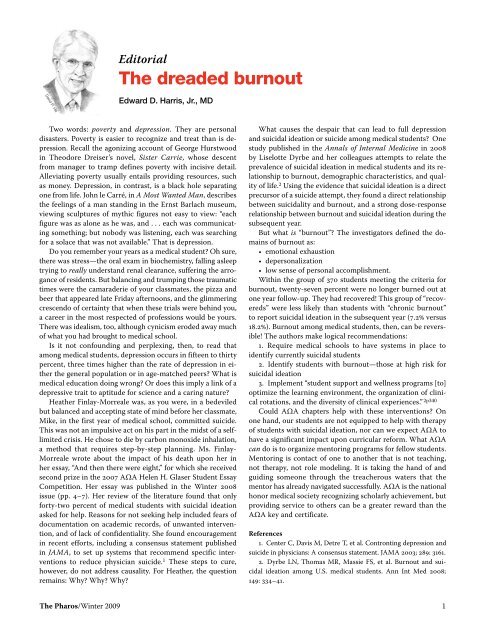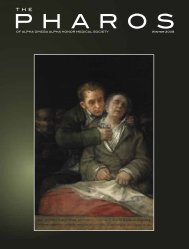Create successful ePaper yourself
Turn your PDF publications into a flip-book with our unique Google optimized e-Paper software.
EditorialThe dreaded burnoutDavid P. HillEdward D. Harris, Jr., MDTwo words: poverty and depression. They are personaldisasters. Poverty is easier to recognize and treat than is depression.Recall the agonizing account of George Hurstwoodin Theodore Dreiser’s novel, Sister Carrie, whose descentfrom manager to tramp defines poverty with incisive detail.Alleviating poverty usually entails providing resources, suchas money. Depression, in contrast, is a black hole separatingone from life. John le Carré, in A Most Wanted Man, describesthe feelings of a man standing in the Ernst Barlach museum,viewing sculptures of mythic figures not easy to view: “eachfigure was as alone as he was, and . . . each was communicatingsomething; but nobody was listening, each was searchingfor a solace that was not available.” That is depression.Do you remember your years as a medical student? Oh sure,there was stress—the oral exam in biochemistry, falling asleeptrying to really understand renal clearance, suffering the arroganceof residents. But balancing and trumping those traumatictimes were the camaraderie of your classmates, the pizza andbeer that appeared late Friday afternoons, and the glimmeringcrescendo of certainty that when these trials were behind you,a career in the most respected of professions would be yours.There was idealism, too, although cynicism eroded away muchof what you had brought to medical school.Is it not confounding and perplexing, then, to read thatamong medical students, depression occurs in fifteen to thirtypercent, three times higher than the rate of depression in eitherthe general population or in age-matched peers? What ismedical education doing wrong? Or does this imply a link of adepressive trait to aptitude for science and a caring nature?Heather Finlay-Morreale was, as you were, in a bedeviledbut balanced and accepting state of mind before her classmate,Mike, in the first year of medical school, committed suicide.This was not an impulsive act on his part in the midst of a selflimitedcrisis. He chose to die by carbon monoxide inhalation,a method that requires step-by-step planning. Ms. Finlay-Morreale wrote about the impact of his death upon her inher essay, “And then there were eight,” for which she receivedsecond prize in the 2007 AΩA Helen H. Glaser Student EssayCompetition. Her essay was published in the Winter 2008issue (pp. 4–7). Her review of the literature found that onlyforty-two percent of medical students with suicidal ideationasked for help. Reasons for not seeking help included fears ofdocumentation on academic records, of unwanted intervention,and of lack of confidentiality. She found encouragementin recent efforts, including a consensus statement publishedin JAMA, to set up systems that recommend specific interventionsto reduce physician suicide. 1 These steps to cure,however, do not address causality. For Heather, the questionremains: Why? Why? Why?What causes the despair that can lead to full depressionand suicidal ideation or suicide among medical students? Onestudy published in the Annals of Internal Medicine in 2008by Liselotte Dyrbe and her colleagues attempts to relate theprevalence of suicidal ideation in medical students and its relationshipto burnout, demographic characteristics, and qualityof life. 2 Using the evidence that suicidal ideation is a directprecursor of a suicide attempt, they found a direct relationshipbetween suicidality and burnout, and a strong dose-responserelationship between burnout and suicidal ideation during thesubsequent year.But what is “burnout”? The investigators defined the domainsof burnout as: Within the group of 370 students meeting the criteria forburnout, twenty-seven percent were no longer burned out atone year follow-up. They had recovered! This group of “recovereds”were less likely than students with “chronic burnout”to report suicidal ideation in the subsequent year (7.2% versus18.2%). Burnout among medical students, then, can be reversible!The authors make logical recommendations:1. Require medical schools to have systems in place toidentify currently suicidal students2. Identify students with burnout—those at high risk forsuicidal ideation3. Implement “student support and wellness programs [to]optimize the learning environment, the organization of clinicalrotations, and the diversity of clinical experiences.” 2p340Could AΩA chapters help with these interventions? Onone hand, our students are not equipped to help with therapyof students with suicidal ideation, nor can we expect AΩA tohave a significant impact upon curricular reform. What AΩAcan do is to organize mentoring programs for fellow students.Mentoring is contact of one to another that is not teaching,not therapy, not role modeling. It is taking the hand of andguiding someone through the treacherous waters that thementor has already navigated successfully. AΩA is the nationalhonor medical society recognizing scholarly achievement, butproviding service to others can be a greater reward than theAΩA key and certificate.References1. Center C, Davis M, Detre T, et al. Contronting depression andsuicide in physicians: A consensus statement. JAMA 2003; 289: 3161.2. Dyrbe LN, Thomas MR, Massie FS, et al. Burnout and suicidalideation among U.S. medical students. Ann Int Med 2008;149: 334–41.The Pharos/Winter 2009 1














